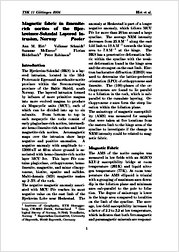Magnetic fabric in ilmeniterich norites of the Bjerkreimer-Sokndal Layered Intrusion, Norway
Hirt, Ann M.
Schmidt, Volkmar
McEnroe, Suzanne
Heidelbach, Florian
Robinson, Peter
Universitätsverlag Göttingen
Sammelband- / Konferenzbeitrag
Verlagsversion
Deutsch
Hirt, Ann M.; Schmidt, Volkmar; McEnroe, Suzanne; Heidelbach, Florian; Robinson, Peter, 2006: Magnetic fabric in ilmeniterich norites of the Bjerkreimer-Sokndal Layered Intrusion, Norway. In: Philipp, S.; Leiss, B; Vollbrecht, A.; Tanner, D.; Gudmundsson, A. (eds.): 11. Symposium "Tektonik, Struktur- und Kristallingeologie"; 2006, Univ.-Verl. Göttingen, S. 91 - 93., , DOI: 10.23689/fidgeo-1831.
 |
Dokument öffnen: |
The Bjerkreim-Sokndal (BKS) is a layered
intrusion, located in the Mid-
Proterozoic Egersund anorthosite-norite
province within the Sveconorwegian
province of the Baltic Shield, south
Norway. The layered intrusion formed by influxes of more primitive magma
into more evolved magma to produce
six Megacyclic units (MCU), each of
which can be divided into up to six
subunits. From bottom to top in
each megacycle the rocks consist of
early plagioclase-rich norites, intermediate
hemo-ilmenite-rich norites and later
magnetite-rich norites. Aeromagnetic
maps over the intrusion show large
negative and positive anomalies. A
negative anomaly with amplitude to -
13000 nT at 60m above ground is associated
with hemo-ilmenite-rich norite
layer MCU Ive. This layer IVe contains
plagioclase, orthopyroxene, hemoilmenite,
magnetite, and minor clinopyroxene,
biotite, apatite and sulfides.
Multi-domain (MD) magnetite makes
up 2–3% of the rock.
The negative magnetic anomaly associated
with MCU IVe reaches its most
negative value on the east limb of the
Bjerkreim Lobe near Heskestad. The
anomaly at Heskestad is part of a longer
negative anomaly, which follows MCU
IVe for more than 20 km around a large
syncline. The average NRM intensity
decreases from 25AM−1 along the east
fold limb to 10AM−1 towards the hinge
area to 7AM−1 at the hinge. The
BKS has a penetrative deformation fabric
within the syncline with the weakest
deformation found in the hinge area
and the strongest on the east limb. Electron
backscatter diffraction (EBSD) was
used to determine the lattice-preferred
orientation (LPO) of orthopyroxene and
ilmenite. The (100)-planes of the orthopyroxenes
are found to lie parallel
to a foliation in the rock, which is subparallel
to the cumulate layering. Orthopyroxene
c-axes form the steep lineation
within the foliation plane.
The anisotropy of magnetic susceptibility
(AMS) was measured for samples
that were taken at five locations from
the eastern limb to the hinge area of the
syncline to investigate if the change in
NRM intensity could be related to magnetic
fabric.

